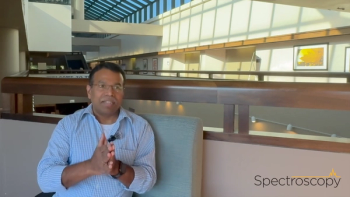
How the New Jersey State Police Are Using FT-IR and Raman Spectroscopy
Pakorn Patimetha, Detective Sergeant with the New Jersey State Police's Hazardous Materials Response Unit spoke to Spectroscopy about how officers use portable spectroscopy technology to detect potentially harmful materials at crime scenes.
Portable spectroscopy technology like Fourier transform infrared (FT-IR) and Raman spectroscopy are increasingly used by first responders in the field to detect hazardous materials.
The New Jersey State Police’s Hazardous Materials Response Unit is increasingly training officers to be able to detect illicit substances like fentanyl to help prevent drug overdoses and protect the public, and police officers, from exposure. Nearly 108,000 people died from drug overdoses in 2022, and a staggering 81,806 of those deaths were from opioids, according to data from the
Spectroscopy spoke with Pakorn Patimetha, Detective Sergeant with the New Jersey State Police's Hazardous Materials Response Unit (HMRU), to discuss how portable spectroscopy technologies are an integral part of their work.
How are portable spectroscopy tools used by the New Jersey HMRU and Bomb Unit for criminal investigations?
HMRU works in conjunction with our Bomb Unit in the investigation and the render safe protocols of improvised explosive devices (IED) and homemade explosives (HME) clandestine laboratories. The most encountered HME’s are simply binary mixtures of oxidizers and fuels. These readily available household precursor chemicals have very similar physical appearances to one another. The oxidizers and fuels are relatively stable and benign in their pure form, but once they are combined, the mixture will become reactive and explode. Portable analytical instruments such as FT-IR and Raman spectrometers enable us to quickly and accurately identify the precursor chemicals and finished explosive mixtures in field. I like to think that our laboratory scientists appreciate knowing which bags of white powder submitted for analysis contained potassium chlorate, powder sugar, or a mixture of the two ingredients.
What are some the most common substances officers are analyzing?
HMRU is responsible for providing technical support to various law enforcement agencies for any investigation involving chemical biological radiological nuclear and explosive (CBRNE) materials. We are often tasked with the detection and identification of organic, inorganic chemicals, and radioactive materials. However, most analyzed materials are found in clandestine laboratories. These makeshift laboratories are often used in the manufacturing of illicit narcotic substances and HME. Additionally, we assist various narcotic units with the field identification of various illicit drugs and precursor chemicals. In 2023 and 2024, the bulk of materials that we analyzed were fentanyl-based narcotics in various forms and mixtures as well as precursor chemicals.
What are some of the advantages to using portable FT-IR and Raman spectrometers for forensic analysis?
These instruments are invaluable tools to our unit. The portable instruments enable the members of HMRU to quickly and accurately identify various unknown substances in the field. For instance, Raman instruments can analyze a substance through an unopened container which reduces the need to open and handle multiple packages. This capability reduces the potential for accidental submission of hazardous substances to our forensic laboratory. Lastly, the ability to quickly and accurately identify narcotic substances in the field rather than waiting for 60 days for a laboratory analysis enhance the effectiveness and efficiency of our investigation.
What are some the challenges analysts encounter in the field when using portable Raman and FT-IR spectrometers to test potentially explosive or hazardous materials? How do they address these challenges?
The main challenges that we encounter in the field are related to the concentration and purity of the materials. For instance, pure and unadulterated fentanyl is relatively easy to detect and identify. On the other hand, fentanyl mixed with multiple adulterants and bulking agents challenge the detection limit of any spectrometer. For instance, a counterfeit oxycodone tablet may contain the following ingredients: acetaminophen, micro-cellulose, xylazine, caffeine, and a minute amount of fentanyl. Samples with the poly-drug mixtures require us to use more technology and extraction methods to remove the impurities.
The most obvious solution for identification of complex mixtures is to use our mobile gas chromatography mass spectrometer (GC–MS). Unfortunately, this instrument is not readily available without advance planning and preparation. For fentanyl in the field, we simply incorporate the use of technologies such as colorimetric and immuno-assay tests. Depending on adulterants, we have had success using a solvent extraction method and the recrystallization of the narcotic substance(s) for analysis with the FT-IR.
Explosive materials, on the other hand, are a relatively straightforward process and easy to analyze with any spectrometer, such as the FT-IR and Raman. The main risk is the sample collection process and the potential of igniting the material with the heat generated from the laser of the Raman instrument. This risk can easily be mitigated by using only a small amount of the sample and avoiding using Raman instruments on dark colored samples. Binary explosives, where elemental metals such as aluminum or magnesium are used as a fuel can present a challenge to optical spectrometers. However, these metals can simply be extracted and identify with the use of simple wet chemistry reagent testing.
What training is required for first responders who are using this technology?
Most of the field spectrometers (FT-IR and Raman) are relatively user friendly with only minimal amount of sample preparation. For the most part, initial training offered by the instrument manufacturer and in-house training is more than adequate to use these instruments. Our unit members attend the following mandatory training: 80 hours hazardous materials technicians and specialized training in the following area: gas analysis, chemical warfare agents (CWA), explosives and narcotic substances. On average, it takes about 1.5 to 2 years for a new unit member to be consider proficient in the necessary skills combine with formal training and on the job training requirements.
What do you expect to see in the future of forensic analysis using spectroscopy tools?
I would think that the instruments would most likely get smaller with longer battery life. Additionally, the rapid advancement of artificial intelligence (AI) would make it possible for the instrument’s algorithms to be better at identifying various components in the mixture without the need of a spectroscopist to interpret the spectra. Lastly, I would hope that more benchtop technologies and instruments can be made portable and available to the first responders.
Is there any else that you think our readership, which is made up of experts in analytical chemistry, should know about your work?
Our mission is not to replace confirmatory testing by accredited laboratories, but rather to provide technical services and information to the investigators in the field so they can make the best and safest decisions based on the information available.
Newsletter
Get essential updates on the latest spectroscopy technologies, regulatory standards, and best practices—subscribe today to Spectroscopy.





